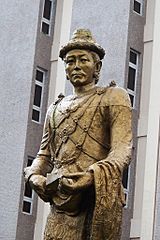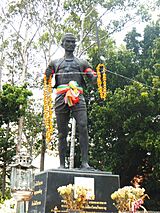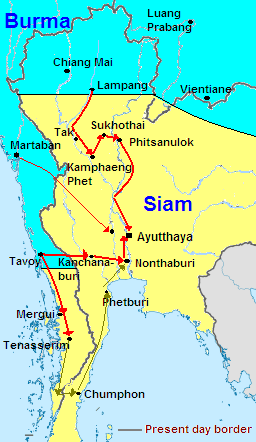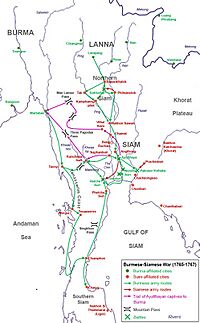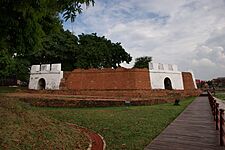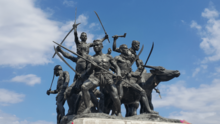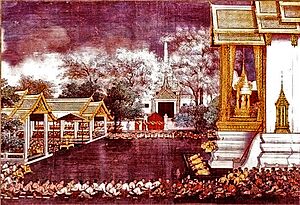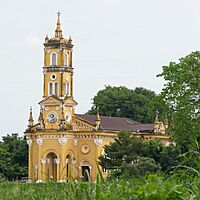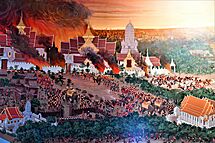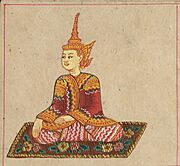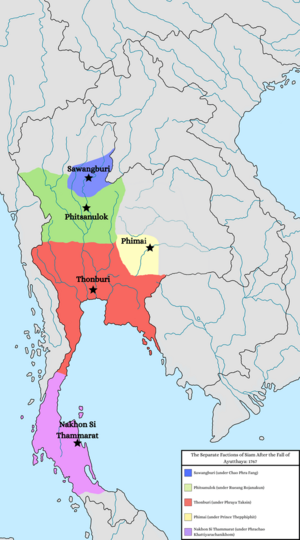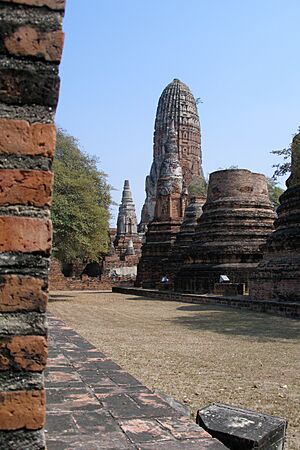Burmese–Siamese War (1765–1767) facts for kids
Quick facts for kids War of the second fall of Ayutthaya |
|||||||||
|---|---|---|---|---|---|---|---|---|---|
| Part of Burmese–Siamese wars | |||||||||
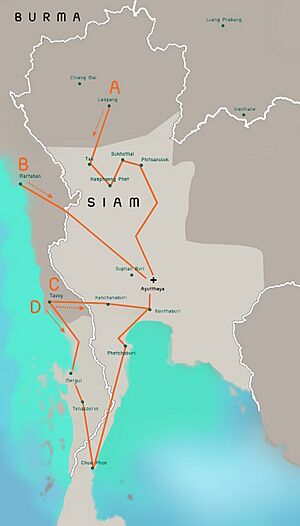
|
|||||||||
|
|||||||||
| Belligerents | |||||||||
| Commanders and leaders | |||||||||
Tavoy column: Chiang Mai column: |
|||||||||
| Units involved | |||||||||
|
Including: 1 British sloop-of-war |
||||||||
| Strength | |||||||||
|
Initial invasion force:
Outer Ayutthaya: 50,000 Siege of Ayutthaya: 40,000+ |
Initial defenses:
1 British sloop-of-war Outer Ayutthaya: 50,000 Siege of Ayutthaya: unknown |
||||||||
| Casualties and losses | |||||||||
| Unknown | Approximately 200,000 soldiers and civilians killed | ||||||||
The Burmese–Siamese War (1765–1767) was a big conflict between Burma and the Ayutthaya Kingdom of Siam. It's also known as the War of the Second Fall. This war lasted from 1765 to 1767 and led to the end of the Ayutthaya Kingdom, which had existed for 417 years.
Burma became very strong in the mid-1700s under its new Konbaung dynasty. In 1760, King Alaungpaya of Burma tried to invade Siam but had to retreat. His son, Prince Myedu, learned a lot from this first invasion. Prince Myedu later became King Hsinbyushin in 1763. He was determined to finish what his father started: conquering Ayutthaya.
In 1764, King Hsinbyushin sent two large Burmese armies to attack Siam. One army, led by Ne Myo Thihapate, came from the north. The other, led by Maha Nawrahta, came from the west. Siam's defenses were weak because there hadn't been major threats for a long time. Also, Siam had trouble getting enough soldiers.
Contents
How the War Started
Burma's Rise to Power
In the mid-1700s, the old Burmese Toungoo dynasty became weak. The Mon people in Lower Burma broke free and formed their own kingdom. But a local leader named Aung Zeiya rallied the Burmese people. He became King Alaungpaya in 1752, starting the new Konbaung dynasty.
Alaungpaya gradually took control of all of Burma. He even captured French ships with cannons and muskets, which greatly improved the Burmese army. By 1757, he had united Upper and Lower Burma.
Siam's Internal Issues
Siam hadn't faced a serious Burmese invasion since 1593. Because of this long peace, Siam's defense system wasn't kept up. There were also many internal conflicts among royal princes and nobles.
Siam's military relied on common people joining the army. But in the 1700s, many commoners became rich by growing rice for export to China. They didn't want to join the army and found ways to avoid it. This meant Siam had fewer soldiers and a weaker defense. The government focused more on preventing internal rebellions than on defending against outside attacks.
Royal Family Problems
King Borommakot of Ayutthaya had problems with his sons. His first heir, Prince Thammathibet, died after being punished. The king then chose Prince Uthumphon as the next heir, skipping over his older brother, Prince Ekkathat, who the king thought was not capable.
When King Borommakot died in 1758, Uthumphon became king. But Ekkathat put pressure on him. So, Uthumphon gave up the throne after only a month and became a Buddhist monk. Ekkathat then became King Ekkathat, the last king of Ayutthaya.
Burmese Invasion of 1760
Burma and Siam both wanted control of the Tenasserim Coast. In 1758, Siam refused to hand over some Mon rebels to Burma. King Alaungpaya saw this as Siam supporting his enemies, so he decided to attack Siam.
In January 1760, Burmese forces quickly took control of the Tenasserim Coast. Siamese armies tried to stop them but were defeated. The Burmese reached the outskirts of Ayutthaya in April 1760. They fired cannons at the city, damaging the royal palace. However, the rainy season began, making the area swampy and difficult for the Burmese. King Alaungpaya also fell ill. So, the Burmese had to retreat, and Alaungpaya died on the way back. Siam was saved for a short time.
Burma Prepares for a New Attack
Burma's Plan
King Hsinbyushin, Alaungpaya's son, had learned from the 1760 war. He planned a two-sided attack on Ayutthaya, from both the north and the south. He wanted to start the invasion early in the rainy season. This way, his armies would be close to Ayutthaya when the dry season began, giving them more time to fight.
Conquering Neighbors

Before attacking Siam, Burma wanted to control the areas around it.
- Lanna (Northern Thailand): Lanna had been under Burmese rule before but became independent. In 1762, Burma sent an army to conquer Chiang Mai, the main city of Lanna. Chiang Mai fell to the Burmese in August 1763. Many people from Chiang Mai were moved to Burma.
- Laos: The Lao kingdom of Lanxang had split into three smaller kingdoms. In 1764, one of the Lao kings asked Burma to invade his rival, Luang Prabang. Burmese forces conquered Luang Prabang in March 1765. The other Lao kingdom, Vientiane, then submitted to Burma. This gave Burma control over Siam's northern borders and access to more soldiers and resources.
Burmese Invasion Begins
Attack on Western Siam
In December 1764, Maha Nawrahta led a Burmese army of 20,000 men to Tavoy. They quickly took Tavoy, Mergui, and Tenasserim in January 1765. King Hsinbyushin sent 10,000 more soldiers to Maha Nawrahta, bringing his total force to 30,000.
The Burmese then invaded Western Siam, burning towns like Chumphon and Pranburi. Siamese forces tried to stop them but were defeated. Many Western Siamese cities like Ratchaburi, Phetchaburi, and Kanchanaburi quickly fell. The Burmese treated towns that surrendered well, but punished those that resisted. They also forced captured Siamese men to join their army.
Northern Army Advances
In August 1765, Nemyo Thihapate and his army, now including 43,000 men from Lanna and Laos, began their attack on Northern Siam. They moved slowly at first because of the rainy season and local resistance. They captured Sawankhalok, Sukhothai, and Tak. The Burmese used the same policy: spare towns that surrendered, punish those that fought. They also forced captured Northern Siamese men to join their army.
Siege of Ayutthaya Begins
Battles Around the Capital
By January 1766, both Burmese armies had reached Ayutthaya.
- Nemyo Thihapate's northern army camped to the north of Ayutthaya.
- Maha Nawrahta's western army camped to the west.
King Ekkathat sent Siamese armies to stop them, but they were defeated in battles like Paknam Prasop and Wat Phukhaothong. The Siamese lost many soldiers and weapons. The Burmese then surrounded Ayutthaya, starting a long siege.
Siam's Defense Strategy
Ayutthaya was built on an island, surrounded by rivers that acted as a natural moat. Its city walls were strong, built with the help of French architects. The Siamese hoped to defend the city by staying inside its walls and waiting for the rainy season. They believed the floods would force the Burmese to retreat, as happened in 1760.
However, King Hsinbyushin had a different plan. He ordered his armies to stay and endure the rainy season. The Burmese built embankments and used boats to move around during the floods. This turned the siege into a test of endurance.
The Bang Rachan Story
While Ayutthaya was under siege, a group of Siamese villagers in Bang Rachan, to the north, started a local resistance. They were led by commoners like Nai Thaen and Nai Chan Nuad Kheo, and inspired by a monk named Phra Acharn Thammachot.
These villagers fought bravely against smaller Burmese forces. They managed to repel eight Burmese attacks over five months. They even tried to make their own cannons. However, Ayutthaya's king refused to send them cannons, fearing they would fall into Burmese hands. Eventually, the Bang Rachan camp fell in June 1766. This story became a symbol of Siamese patriotism later on.
Burma's Other War: China
At the same time, Burma was also fighting a war with Qing China on its northern border. This was a big problem for Burma because China had the largest army in the world. The Chinese invaded Burma several times, but the Burmese managed to push them back.
This war with China made King Hsinbyushin eager to finish the war in Siam. In January 1767, he ordered his generals in Ayutthaya to capture the city quickly so the soldiers could be sent to fight the Chinese.
Phraya Tak Leaves Ayutthaya
By late 1766, the situation inside Ayutthaya was terrible. Food was running out, and people were starving. Many citizens surrendered to the Burmese. Phraya Tak, a Siamese general of Chinese descent, realized that Ayutthaya would fall.
On January 4, 1767, Phraya Tak and about 500 of his followers broke through the Burmese lines to the east. He fought his way through Burmese forces in Eastern Siam and eventually settled in Rayong, a town on the eastern coast that hadn't been invaded. He planned to build a new force there.
Final Attack on Ayutthaya
The Burmese intensified their attack. They built tall towers around Ayutthaya to fire cannons into the city. They also started digging tunnels under the city walls.
Siamese defenders, including Chinese and Portuguese fighters, tried to resist. But their forces were weakened. In March 1767, the Burmese captured the last Siamese defense points on the southern side, including the Saint Joseph Church and Portuguese settlements. The Burmese then burned down all the churches.
Maha Nawrahta, one of the main Burmese commanders, died from illness in March 1767. Nemyo Thihapate took over command of all Burmese forces.
The Fall of Ayutthaya
On April 7, 1767, the Burmese set fire to the wooden supports under the Ayutthaya city wall through their tunnels. The northeastern part of the wall collapsed. Burmese soldiers stormed into the city.
What followed was terrible destruction. The Burmese killed many people, burned down royal palaces, temples, and homes. They looted treasures. King Ekkathat, the last king of Ayutthaya, was killed. About 30,000 Siamese people, including the royal family, skilled workers, and cultural items, were taken back to Burma. The beautiful Phra Si Sanphet Buddha image, a symbol of Ayutthaya, was destroyed for its gold.
The city of Ayutthaya, once a large and wealthy capital, was left in ruins. The 417-year-old Ayutthaya Kingdom was gone. Siam was left in chaos, with no central government.
After the Fall
Burmese Leave Siam
After two months, Nemyo Thihapate and most of the Burmese army left Ayutthaya in June 1767. They took the Siamese captives, treasures, and weapons back to Burma. King Uthumphon, the monk-king, and many Siamese nobles were among those taken to the Burmese capital, Ava.
A small Burmese force was left behind to control the area around Ayutthaya. Many Siamese people fled to areas not reached by the Burmese, like Chanthaburi in the east and Nakhon Si Thammarat in the south.
Siam's New Beginning
After Ayutthaya fell, Siam broke into several smaller regions, each with its own leader.
- Phitsanulok in the north.
- Phimai in the northeast.
- Nakhon Si Thammarat in the south.
- Sawangkhaburi (Fang) led by a monk.
- Phraya Tak in the east.
Phraya Tak, who had escaped the siege, began to gather his forces. In October 1767, he sailed his fleet to the Chao Phraya River. In November, he captured Thonburi and then attacked the remaining Burmese forces near Ayutthaya. He liberated Ayutthaya on November 6, 1767.
Phraya Tak found Ayutthaya too ruined to be a capital. So, he moved the royal seat to Thonburi, south of Ayutthaya. On December 28, 1767, Phraya Tak became King Taksin, starting the Thonburi Kingdom.
King Taksin then spent the next few years reuniting Siam. He defeated the other regional leaders one by one. By 1770, he had become the sole ruler of a unified Siam.
Later Wars with Burma
The fall of Ayutthaya changed Siam's approach to warfare. Instead of waiting for invaders at the capital, Siam adopted an "active defense" strategy. They fought enemies at the borders and recruited more soldiers. After 1767, Burmese armies never reached the Siamese capital again.
Siam also learned that Burma used neighboring kingdoms like Lanna and Laos as bases. So, Siam decided to take control of these areas. King Taksin conquered Chiang Mai in 1774.
Burma tried to invade Siam again in 1775–1776, but the new Siamese army was stronger. The Burmese general Maha Thiha Thura besieged Phitsanulok, but when news of the Burmese king's death arrived, the Burmese had to retreat. This was the last major Burmese invasion of Siam.
Ayutthaya's Ruins
After 1767, Ayutthaya remained in ruins. Many people had buried their treasures before the city fell. So, Ayutthaya became a place for treasure hunters.
When King Rama I founded the new capital of Bangkok in 1782, bricks from Ayutthaya's ruins were used to build the new city. Ayutthaya became a provincial town. Today, the Ayutthaya Historical Park is a UNESCO World Heritage site, preserving the remains of the old capital.
Lasting Impact
New Siamese Identity
The destruction of Ayutthaya in 1767 led to a new sense of national identity in Siam. Kings like Taksin and Rama I emphasized protecting the kingdom and Buddhism. This idea of "proto-nationalism" helped unite the people and defend against future threats. Later, this developed into modern Thai nationalism.
Thai-Burmese Relations
The war left a negative mark on relations between Thailand and Burma. In Thailand, the fall of Ayutthaya is seen as a great tragedy. Thai history books often describe the Burmese as savage invaders. This view has influenced how many Thai people feel about Burma today.
However, some historians argue that these were wars between kings, not nations. Many Siamese people even fought alongside the Burmese. But this academic view hasn't fully replaced the traditional story in Thai schools.


